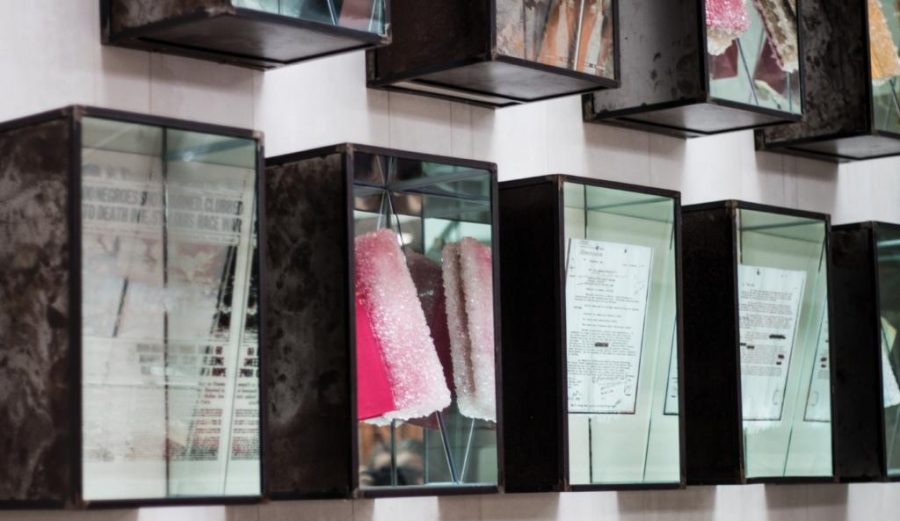The University of Utah’s S.J. Quinney College of Law officially unveiled a new sculpture by Los Angeles-based artist Edgar Arceneaux on Sept. 28.
The sculpture is an original work made specifically for the law school. It’s based on Martin Luther King Jr.’s quote in which he said that “the arc of the moral universe is long, but it bends towards justice.”
Arceneaux, a rising star in the art world, works with a variety of sculpting mediums. His latest project, which is now on display in the lobby of the law building, incorporates a wide variety of materials to achieve its look.
The piece, named “The Crystal Paradox,” includes a variety of metal and glass vitrine light boxes. The boxes are mounted two full stories along a central wall. All of the boxes contain deaccessioned law books and redacted letters from the FBI.
“I used sugar crystals on the books to demonstrate both the destruction of the object and also give a sense of giving it new life,” Arceneaux explained. “The crystals have an embedded paradox. For one, they give the illusion of destroying the books. They also bring a sense of new life because, firstly, they were going to be thrown away. The crystals help the books to be frozen in time. Sugar crystals also are organic and grow like a tree, even though we see them as being stationary.”
The letters included among the books help to tell the story of the United States government’s covert operations from the 1950s to the 1970s to undermine the Civil Rights Movement. Arceneaux intended to explore the story of law as a tool for the people as well as a weapon against people.
“I wanted the students to think about that quote from Dr. King,” Arceneaux said. “It’s a beautiful metaphor, and at the time we’re in right now, we’re all wondering if the law really is leaning toward justice. It makes you wonder if things are ever going to get any better or if it’s just leaning toward the more powerful dominating the less fortunate. The sculpture incorporates the triumphs and tragedies in the everyday. I wanted the students to think about that.”
The glass and mirrors help to accomplish this goal, according to Arceneaux. When students look into the boxes directly, they see themselves reflected back. It creates a mood of introspection, Arceneaux said, bringing the viewer to see themselves within the work.
Arceneaux’s idea was accepted from a number of proposals submitted by artists from around the world. The dean of the law school, Robert Adler, hopes that the sculpture will inspire crucial conversations about both art and social justice. He noted that this is a very polarizing time in history and that the legal community plays a vital part in social justice debates. Adler urged students to go to the law building to see the sculpture.
“I hope that it inspires them with questions,” Adler said. “What role do you want to play? Do you want to go along with the status quo, or do you want to break it?”
c.macdonald@dailyutahchronicle.com


